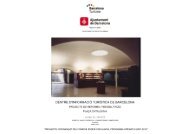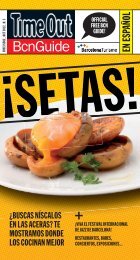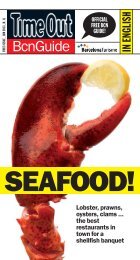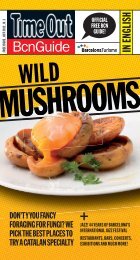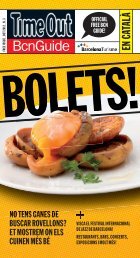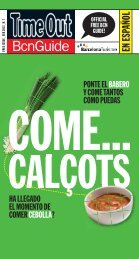History of Catalan cuisine - Turisme de Barcelona
History of Catalan cuisine - Turisme de Barcelona
History of Catalan cuisine - Turisme de Barcelona
Create successful ePaper yourself
Turn your PDF publications into a flip-book with our unique Google optimized e-Paper software.
BARCELONA, 600 YEARS OF GASTRONOMY CULTURE<br />
the first successful <strong>cuisine</strong>: mediaeval cooking<br />
The first recipes in Latin-<strong>de</strong>rived languages 14th and 15th century are in <strong>Catalan</strong>, like the<br />
so-called Sent Soví. Probably much <strong>of</strong> the uniqueness <strong>of</strong> <strong>Catalan</strong> <strong>cuisine</strong> comes from the<br />
fact that it has managed to bring together, from the basis <strong>of</strong> its classical and visigoth<br />
heritage, the fine influences <strong>of</strong> Andalusian culture, thus guaranteeing the<br />
Mediterranean culture and transmission <strong>of</strong> oriental treasures.<br />
The Arabs introduced and reintroduced many products to the Iberian peninsular, some <strong>of</strong><br />
these still play a part in idiosyncratic nature <strong>of</strong> <strong>Catalan</strong> food, like rice, spinach, egg<br />
plants, lemons, sugar or pasta (fi<strong>de</strong>us), and there was a certain taste for greens, which<br />
the philosopher Ramon Llull i<strong>de</strong>ntified as a source <strong>of</strong> health, especially taking into<br />
account that gar<strong>de</strong>n fruits had really un<strong>de</strong>rvalued until then by feudal masters. As well,<br />
the presence <strong>of</strong> fish and other products from the Mediterranean characterised this<br />
mediaeval <strong>Catalan</strong> <strong>cuisine</strong>. And there were also some exquisite sauces like ginestrada, a<br />
cream ma<strong>de</strong> with rise, saffron, with the milk <strong>of</strong> almonds, and costum —exported to a<br />
large extent— ma<strong>de</strong> by cooking poultry in citric fruits, as well as various dishes<br />
1
<strong>de</strong>licately scented with rose water and prohibitive mixes <strong>of</strong> far <strong>of</strong>f spices. Remember that<br />
ginger arrived much before sushi, or corian<strong>de</strong>r before guacamole, and that galangà<br />
came before the Tom Iam soup.<br />
Catalonia shared this way <strong>of</strong> cooking with, firstly<br />
-and in a very special way- Occitània, as it did<br />
with serenading, the trobadors and an<br />
occasional heretic, and afterwards there were<br />
successful contacts with Sicily, Sardinia and the<br />
Italian Peninsular. In the moment when <strong>Catalan</strong> <strong>cuisine</strong> was really foun<strong>de</strong>d, it already<br />
showed its most characteristic trait: the capacity to incorporate the best <strong>of</strong> other<br />
culinary cultures, that for one or another reason, it had come into contact with. This was<br />
not a unique thing; anthropologists have shown that <strong>cuisine</strong> reflects societies quite<br />
clearly. So it is not at all strange that <strong>cuisine</strong> in Catalonia reflected the spirit <strong>of</strong> a place<br />
that was very much a thoroughfare and place <strong>of</strong> arrival, preferring to incorporate that<br />
than resist other styles.<br />
the fusion <strong>of</strong> «new» americas products<br />
With time ultramarine products from the Americas were incorporated into <strong>Catalan</strong><br />
<strong>cuisine</strong>, which without them today would look very different. For example, sausages and<br />
beans (American), Egg plants with peppers (American), Soup <strong>of</strong> Cauliflower and potatoes<br />
(American), and tomato (American)-bread and even<br />
our bread and chocolate (American) for an afternoon<br />
snack.<br />
Mo<strong>de</strong>rn times is not especially good —as everyone<br />
knows— for the production <strong>of</strong> <strong>Catalan</strong> culture, which<br />
was persecuted and occasionally had to hi<strong>de</strong> even in<br />
convents or monasteries. Precisely it was in the<br />
monasteries where many <strong>of</strong> the recipe books <strong>of</strong> the<br />
time were written, faithful to the mediaeval tradition (there was still a fair mix <strong>of</strong> sweet<br />
and salty dishes that were so liked in the Middle Ages, for example, but also with the<br />
healthy meat restrictions as prescribed by monastery rules. And bit by bit the new<br />
2
incorporations began to bring the makeup <strong>of</strong> the dishes, <strong>de</strong>spite not losing their<br />
character, to current day ones.<br />
the first inns<br />
The evolution did not stop there, and the first inns appeared. Sempronio explains in<br />
Quan <strong>Barcelona</strong> portava barret that the word «fonda» (inn) comes from the Arabic word<br />
alfòn<strong>de</strong>c, sort <strong>of</strong> warehouse where, apart<br />
from storing merchandise, the men that<br />
transported the goods also ate and slept; a<br />
sort <strong>of</strong> urban, western caravan harem.<br />
<strong>Barcelona</strong>'s most well known alfòn<strong>de</strong>c was in<br />
the Santa Maria <strong>de</strong>l Mar quarter; later to<br />
become a hostel, which was what came<br />
directly before the fonda.<br />
The first inn owners were Italians and they came in the 18th century. And they would<br />
advertise themselves on woo<strong>de</strong>n boards with pictures <strong>of</strong> falcons or a sabre rather than<br />
with letters for those that could not read. In the book Vint segles <strong>de</strong> cuina a <strong>Barcelona</strong>,<br />
Nèstor Luján explains that the most famous inn belonged to a Sardianian who had<br />
arrived in the city in 1788. In 1815 he opened Beco <strong>de</strong>l Racó, where you could eat rabbit<br />
casserole, potato stew, escu<strong>de</strong>lla, meatball soup, beef stew; a whole series <strong>of</strong> dishes<br />
that we recognise as traditional <strong>Catalan</strong> dishes and that we inclu<strong>de</strong>d in the majority <strong>of</strong><br />
recipes when, with the Renaissance, cooking books reappeared.<br />
«At around the end <strong>of</strong> the 19th century, in the<br />
sisos inns, where you could eat for “sis<br />
quartos” (a small quantity <strong>of</strong> money), the food<br />
on <strong>of</strong>fer was great, nice and very popular. But<br />
there was also a need for a different sort <strong>of</strong><br />
<strong>of</strong>fer <strong>de</strong>dicated to the new emerging social<br />
classes because the so called "gol<strong>de</strong>n age", a<br />
name taken from Europe, was growing in<br />
3
<strong>Barcelona</strong> more and more [...] luxury sweet shops, glove makers, cake shops and<br />
restaurants were setting up like un<strong>de</strong>r a spell», explains Narcís Oller in his famous novel<br />
La febre d’or.<br />
exquisite and bourgeois Cuisine<br />
In Catalonia this exquisite and bourgeois <strong>cuisine</strong>, as only it could be, was also liked. And<br />
it left its mark on those that could afford it.<br />
Meanwhile, as Rusiñol explains, «the workers<br />
that could and their bosses would get out <strong>of</strong><br />
town on Sundays to eat rice and conger with<br />
muscles or grilled lamb». Another great cook <strong>of</strong><br />
the time Ignasi Domènech, who had worked<br />
with Esc<strong>of</strong>fier, said this part <strong>of</strong> traditional<br />
cooking, that we have seen, continued to be ad<strong>de</strong>d to with outsi<strong>de</strong> influences.<br />
The Spanish Civil War was horrible and the dictatorship a disaster. But many people from<br />
other parts <strong>of</strong> the State came to Catalonia, bringing new cultural riches.<br />
THE GASTONOMIC DIFFERENCE: ANTROPOLOGY AND CULTURE<br />
Recently, gastronomy has become totally accepted as an essential part <strong>of</strong> culture.<br />
That is why <strong>cuisine</strong> is a faithful reflection <strong>of</strong> the<br />
people and societies that put down its roots; this<br />
means, cooking forms an essential part <strong>of</strong> the<br />
cultural structure <strong>of</strong> every people: «we are what<br />
we eat», said wise men. And that is why the way<br />
we eat is a key indicator. In this sense the power <strong>of</strong><br />
popular <strong>Catalan</strong> recipes has become public and<br />
noteworthy, a valuable patrimony that is worth saving and yet is in constant evolution.<br />
As well, showing what is our own way <strong>of</strong> cooking, brings us to another function <strong>of</strong><br />
gastronomy; the value <strong>of</strong> traditional cooking as part <strong>of</strong> a necessary integrating strategy<br />
for immigration.<br />
4
And the tablecloths <strong>of</strong> Catalonia contain lots <strong>of</strong> history. A series <strong>of</strong> menus, meals, and<br />
dishes have para<strong>de</strong>d on the tables <strong>of</strong> our country, and its capital for the last centuries.<br />
These are testimonies <strong>of</strong> their time, an interesting living museum <strong>of</strong> Catalonia, Europe,<br />
and its travels. Our <strong>cuisine</strong> is an inheritance from and tribute to all the civilisations that<br />
have ruled Europe since Imperial Roman times. The result is a recipe book that clearly<br />
shows what <strong>Catalan</strong>s are like, and that helps <strong>de</strong>fine their i<strong>de</strong>ntity and construct the<br />
culture and intellectual background <strong>of</strong> Catalonia.<br />
5








